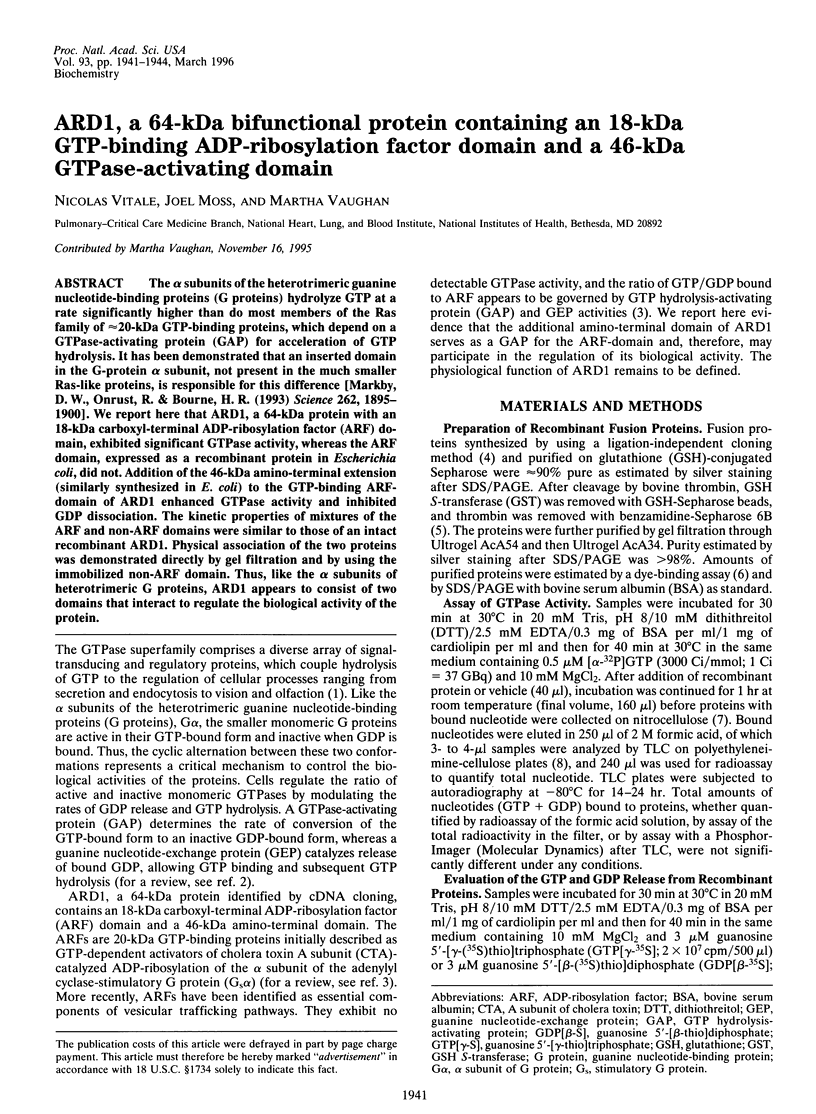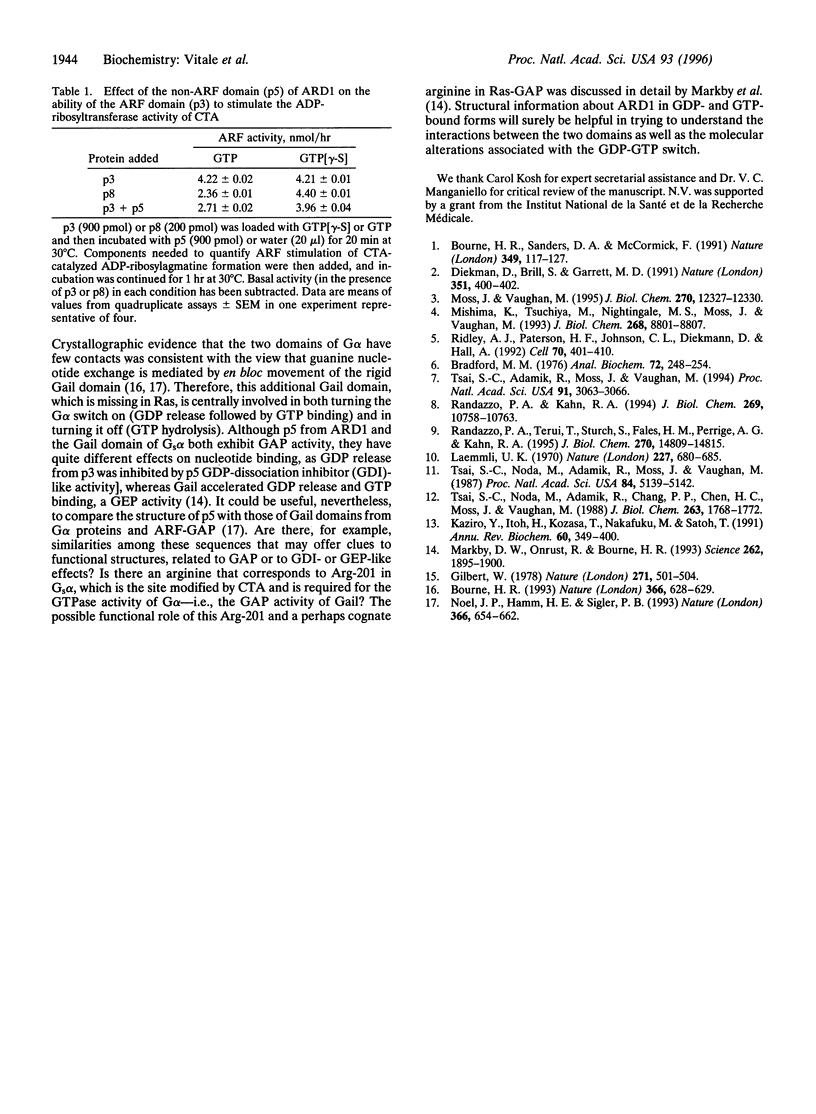Abstract
The alpha subunits of the heterotrimeric guanine nucleotide-binding proteins (G proteins) hydrolyze GTP at a rate significantly higher than do most members of the Ras family of approximatelly 20-kDa GTP-binding proteins, which depend on a GTPase-activating protein (GAP) for acceleration of GTP hydrolysis. It has been demonstrated that an inserted domain in the G-protein alpha subunit, not present in the much smaller Ras-like proteins, is responsible for this difference [Markby, D. W., Onrust, R. & Bourne, H. R. (1993) Science 262, 1895-1900]. We report here that ARD1, a 64-kDa protein with an 18-kDa carboxyl-terminal ADP-ribosylation factor (ARF) domain, exhibited significant GTPase activity, whereas the ARF domain, expressed as a recombinant protein in Escherichia coli, did not. Addition of the 46-kDa amino-terminal extension (similarly synthesized in E. coli) to the GTP-binding ARF-domain of ARD1 enhanced GTPase activity and inhibited GDP dissociation. The kinetic properties of mixtures of the ARF and non-ARF domains were similar to those of an intact recombinant ARD1. Physical association of the two proteins was demonstrated directly by gel filtration and by using the immobilized non-ARF domain. Thus, like the alpha subunits of heterotrimeric G proteins, ARD1 appears to consist of two domains that interact to regulate the biological activity of the protein.
Full text
PDF



Images in this article
Selected References
These references are in PubMed. This may not be the complete list of references from this article.
- Bourne H. R. GTPases. A turn-on and a surprise. Nature. 1993 Dec 16;366(6456):628–629. doi: 10.1038/366628a0. [DOI] [PubMed] [Google Scholar]
- Bourne H. R., Sanders D. A., McCormick F. The GTPase superfamily: conserved structure and molecular mechanism. Nature. 1991 Jan 10;349(6305):117–127. doi: 10.1038/349117a0. [DOI] [PubMed] [Google Scholar]
- Bradford M. M. A rapid and sensitive method for the quantitation of microgram quantities of protein utilizing the principle of protein-dye binding. Anal Biochem. 1976 May 7;72:248–254. doi: 10.1006/abio.1976.9999. [DOI] [PubMed] [Google Scholar]
- Diekmann D., Brill S., Garrett M. D., Totty N., Hsuan J., Monfries C., Hall C., Lim L., Hall A. Bcr encodes a GTPase-activating protein for p21rac. Nature. 1991 May 30;351(6325):400–402. doi: 10.1038/351400a0. [DOI] [PubMed] [Google Scholar]
- Gilbert W. Why genes in pieces? Nature. 1978 Feb 9;271(5645):501–501. doi: 10.1038/271501a0. [DOI] [PubMed] [Google Scholar]
- Kaziro Y., Itoh H., Kozasa T., Nakafuku M., Satoh T. Structure and function of signal-transducing GTP-binding proteins. Annu Rev Biochem. 1991;60:349–400. doi: 10.1146/annurev.bi.60.070191.002025. [DOI] [PubMed] [Google Scholar]
- Laemmli U. K. Cleavage of structural proteins during the assembly of the head of bacteriophage T4. Nature. 1970 Aug 15;227(5259):680–685. doi: 10.1038/227680a0. [DOI] [PubMed] [Google Scholar]
- Markby D. W., Onrust R., Bourne H. R. Separate GTP binding and GTPase activating domains of a G alpha subunit. Science. 1993 Dec 17;262(5141):1895–1901. doi: 10.1126/science.8266082. [DOI] [PubMed] [Google Scholar]
- Mishima K., Tsuchiya M., Nightingale M. S., Moss J., Vaughan M. ARD 1, a 64-kDa guanine nucleotide-binding protein with a carboxyl-terminal ADP-ribosylation factor domain. J Biol Chem. 1993 Apr 25;268(12):8801–8807. [PubMed] [Google Scholar]
- Moss J., Vaughan M. Structure and function of ARF proteins: activators of cholera toxin and critical components of intracellular vesicular transport processes. J Biol Chem. 1995 May 26;270(21):12327–12330. doi: 10.1074/jbc.270.21.12327. [DOI] [PubMed] [Google Scholar]
- Noel J. P., Hamm H. E., Sigler P. B. The 2.2 A crystal structure of transducin-alpha complexed with GTP gamma S. Nature. 1993 Dec 16;366(6456):654–663. doi: 10.1038/366654a0. [DOI] [PubMed] [Google Scholar]
- Randazzo P. A., Kahn R. A. GTP hydrolysis by ADP-ribosylation factor is dependent on both an ADP-ribosylation factor GTPase-activating protein and acid phospholipids. J Biol Chem. 1994 Apr 8;269(14):10758–10763. [PubMed] [Google Scholar]
- Randazzo P. A., Terui T., Sturch S., Fales H. M., Ferrige A. G., Kahn R. A. The myristoylated amino terminus of ADP-ribosylation factor 1 is a phospholipid- and GTP-sensitive switch. J Biol Chem. 1995 Jun 16;270(24):14809–14815. doi: 10.1074/jbc.270.24.14809. [DOI] [PubMed] [Google Scholar]
- Ridley A. J., Paterson H. F., Johnston C. L., Diekmann D., Hall A. The small GTP-binding protein rac regulates growth factor-induced membrane ruffling. Cell. 1992 Aug 7;70(3):401–410. doi: 10.1016/0092-8674(92)90164-8. [DOI] [PubMed] [Google Scholar]
- Tsai S. C., Adamik R., Moss J., Vaughan M. Identification of a brefeldin A-insensitive guanine nucleotide-exchange protein for ADP-ribosylation factor in bovine brain. Proc Natl Acad Sci U S A. 1994 Apr 12;91(8):3063–3066. doi: 10.1073/pnas.91.8.3063. [DOI] [PMC free article] [PubMed] [Google Scholar]
- Tsai S. C., Noda M., Adamik R., Chang P. P., Chen H. C., Moss J., Vaughan M. Stimulation of choleragen enzymatic activities by GTP and two soluble proteins purified from bovine brain. J Biol Chem. 1988 Feb 5;263(4):1768–1772. [PubMed] [Google Scholar]
- Tsai S. C., Noda M., Adamik R., Moss J., Vaughan M. Enhancement of choleragen ADP-ribosyltransferase activities by guanyl nucleotides and a 19-kDa membrane protein. Proc Natl Acad Sci U S A. 1987 Aug;84(15):5139–5142. doi: 10.1073/pnas.84.15.5139. [DOI] [PMC free article] [PubMed] [Google Scholar]





